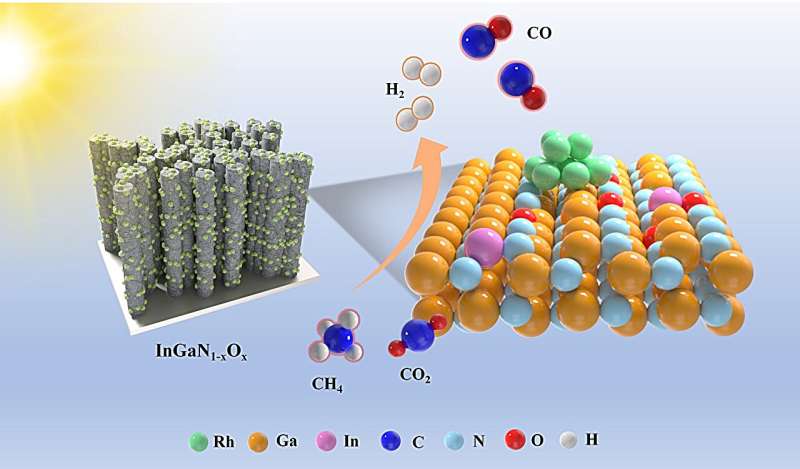This article has been reviewed according to Science X's editorial process and policies. Editors have highlighted the following attributes while ensuring the content's credibility:
fact-checked
trusted source
proofread
A photocatalyst for sustainable syngas production from greenhouse gases

Researchers have developed a novel photocatalyst, named Rh/InGaN1-xOx, which is a nanoarchitecture consisting of rhodium nanoparticles anchored on oxygen-modified indium gallium nitride nanowires grown on silicon substrates.
Under concentrated solar illumination, this composite material demonstrates remarkable performance for the dry reforming of methane (DRM) with CO2, achieving a syngas evolution rate of 180.9 mmol gcat-1 h-1 with 96.3% selectivity. This represents a significant improvement over conventional catalytic systems, which often require high energy inputs and suffer from rapid deactivation.
"Our work represents a major step forward in addressing the dual challenges of greenhouse gas emissions and sustainable energy production," said Prof. Baowen Zhou, the lead researcher from Shanghai Jiao Tong University. "By leveraging the power of solar energy and rationally designed nanoarchitecture, we have demonstrated a green and efficient route for converting waste gases into valuable chemical resources."
The researchers attribute the exceptional performance of their photocatalyst to the synergistic effects arising from the integration of the photo-active InGaN nanowires, oxygen-modified surface, and catalytically active rhodium nanoparticles. Mechanistic studies revealed that the incorporated oxygen atoms play a crucial role in promoting CO2 activation, facilitating CO generation, and suppressing catalyst deactivation via coking deposition.
The findings of this research, published in Science Bulletin, pave the way for the development of advanced photocatalytic systems for the sustainable production of fuels and chemicals from renewable resources. The team believes that their approach can be extended to other important chemical reactions, offering new opportunities for greening the chemical industry.
"We are excited about the prospects of this technology," said Prof. Baowen Zhou. "By further optimizing the catalyst design and reactor configuration, we aim to scale up the process and demonstrate its viability for practical applications."
More information: Yixin Li et al, Rh/InGaN1−O nanoarchitecture for light-driven methane reforming with carbon dioxide toward syngas, Science Bulletin (2024). DOI: 10.1016/j.scib.2024.02.020
Provided by Science China Press




















